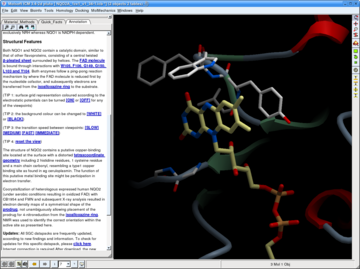Molecular Documents and Presentations (US Patent No:7,880,738) |
ICM now facilitates the production and exchange of interactive 3D and 2D information consisting of multiple interactive views and animations of molecular structures and graphical objects in conjunction with related hyperlinked text, chemical, biological sequence and data views.
The combination of animations and transitions within a doucment or presentation allow for a perception of depth and add a new level of clarity to the details contained within a molecular object. These documents and presentations are ideal for schools, academic laboratories, university educators and companies to communicate and/or teach molecular information and ideas.
They are a great alternative to the one-dimensional powerpoint and pdf files.

Some uses of ICM Molecular Documents and Presentations (US Patent No:7,880,738) include:
- Teaching Molecular Structure and Function in Universities and Schools.
- Sharing diverse molecular data as a single file between colleagues and collaborators.
- Communicating clear and detailed molecular information and animations.
- Presenting molecular structure information in detail at conferences or lab meetings.
- Publishing results.
- Sharing results over the World Wide Web.
The Structural Genomics Consortium at Oxford Univeristy UK already use ICM to generate molecular presentation files. You can download examples of documents and presentations
from their website by clicking here.
Some features of ICM Documents and Presentations include:
- Write and read ICM Documents and Presentations in ICM-Pro. Our free ICM-Browser can be used to view the files.
- Generate molecular slides containing most of the features contained within ICM such as 3D objects, alignments, chemicals, tables and trees ...
- Easy one-click slide navigation.
- Fully-interactive animations including rocking and rotation.
- Fully-interactive smooth transitions. Transitions can include changes in viewpoint, clipping, zooming, appearance and disappearance of presentations, changing colors, or transparency values, and gradual appearance of text labels.
- Animations and Transitions are fully-interruptable without any loss of performance or molecular information. For example, when using ICM during a presentation a member of the audience may ask a specific question relating rto a certain part of the structure. The animation or transition can be interrupted with a single mouse click and the presenter can quickly and easily zoom onto the region of the molecular object in question.
- Hyperlinked text linking to animations and transitions. We have expanded the HTML syntax to enable the actions on objects in the graphical window activated by a single mouse click on anchored text and pictures.
- Small file size enables easy file-sharing and downloading.
- Multi-platform, Windows, Linux, Mac and SGI